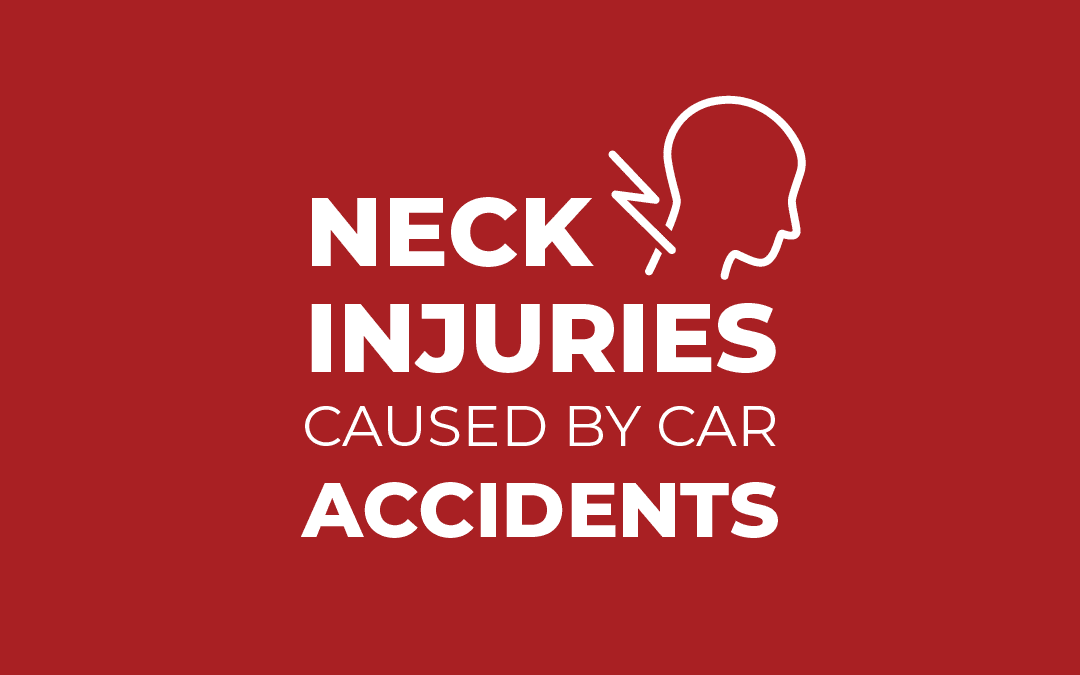Understanding Neck Injuries Caused by Car Accidents in Albuquerque

Neck injuries are among the most common types of injuries following a car accident. Many neck injuries are minor and resolve themselves without medical intervention. However, a high-speed injury can cause debilitating and chronic health conditions from torn ligaments, damaged soft tissues, muscle strain, and more. Determining the severity of a neck injury following a car accident in Albuquerque is essential for your long-term health, any negotiations with the insurance company, and a subsequent personal injury claim.
Let’s take a look at the different types of neck injuries caused by a car accident, symptoms causing neck pain, treatment options, and the lasting impacts they can have on your life.
Types of Common Neck Injuries
Whiplash injury
In Albuquerque, where rear-end collisions frequently happen on highways and busy streets, a common neck injury caused by a car accident is called whiplash. Whiplash injuries are perhaps the most well-known neck injury associated with car accidents. It occurs when the head and neck are thrown in a rapid back-and-forth motion, causing strain on the neck’s joints, muscles, ligaments, intervertebral discs, and nerves.
Cervical strain or sprain
A neck sprain or strain happens when the muscles or ligaments in the neck get stretched or torn due to sudden movements or impacts, like those from a car accident. Strains involve the muscles, while sprains affect the ligaments that hold the bones together.
Facet joint injuries
Facet joints help stabilize the spine and enable movements like bending and twisting. Injury to these joints can lead to pain, stiffness, and reduced flexibility in the affected area.
Cervical radiculopathy (pinched nerve in the neck)
Cervical radiculopathy refers to the compression or irritation of a nerve root in the cervical spine (neck region). Pinched nerves occur when a spinal disc herniates or degenerates, causing pressure on the nerve roots as they exit the spinal column.
Cervical spondylosis (degenerative changes in the cervical spine)
The forceful impact and abrupt movements during a collision can accelerate wear and tear on the cervical spine, leading to the onset or worsening of cervical spondylosis. Injuries sustained during the accident, such as whiplash, can further contribute to the degeneration of the cervical spine over time.
Spinal cord compression or injury
Although spinal cord compression or injury is not strictly a “neck injury,” it can still be a significant consequence of trauma sustained to the cervical spine area in car accidents. In car accidents, sudden and forceful movements can occur during impact, which may lead to compression or trauma to the spinal cord within the neck area.
Herniated disc or bulging discs in the cervical spine
While herniated discs are most commonly associated with back injuries, they can also occur in the neck. The neck and spine are comprised of vertebrae that stack on top of one another, cushioned by discs. Discs have a soft center surrounded by a rubbery exterior. A herniated disc occurs when the rubbery exterior portion of the disc tears, allowing the soft center to push out.
Soft tissue damage
These injuries typically involve damage to muscles, ligaments, tendons, and other connective tissues in the neck. The sudden impact and jerking movements during a collision can strain or tear these soft tissues, leading to symptoms such as neck pain, stiffness, swelling, and tenderness.
Cervical fractures or dislocations
The neck contains seven cervical vertebrae, and the impact of a car accident can cause any of them to fracture. These cervical fracture injuries (more commonly known as a broken neck) are especially dangerous, as they can lead to lifelong complications such as paralysis. They can also be deadly.
Symptoms of Possible Neck Injuries
It’s essential to note that not all neck injuries become apparent immediately after a car accident. In some cases, the adrenaline rush and shock from the collision can mask many symptoms of pain and discomfort, leading you to believe you weren’t seriously harmed in the car accident. Be aware of these common symptoms you may experience after a car wreck:
- Stiff muscles around the head and neck
- Muscle spasms in the neck and upper back
- Limited range of motion
- Headaches, particularly at the base of the skull
- Numbness or tingling in the arms or hands
- Weakness in the arms or hands
- Radiating pain from the neck into the shoulders or arms
- Difficulty turning the head or tilting it backward or forward
- Sensitivity to touch around the neck and shoulders
It’s important not to delay your treatment after a car accident. Even if neck pain isn’t immediately felt after the accident, it may manifest or become noticeable weeks or even months later.
Diagnosing Neck Injuries
Neck injuries causing pain can be difficult to diagnose and should be assessed by a medical professional. Seek medical attention following a car accident from a healthcare provider to make sure any issues are found quickly and addressed. Plus, your medical records and x-rays will help support your personal injury claim for compensation during a personal injury lawsuit. Here are some key aspects involved in diagnosing your injuries after a car accident.
Medical examination: Healthcare providers will assess symptoms that are causing neck pain including stiffness, numbness, and weakness in the neck and surrounding areas. Through a detailed physical examination, including testing the usual range of motion and muscle strength, doctors can better understand your injury and plan appropriate treatment.
Imaging studies: X-rays serve as the primary imaging tool for evaluating fractures, dislocations, and alignment issues in the cervical spine. Computed Tomography (CT) scans offer detailed cross-sectional views. Magnetic Resonance Imaging (MRI) provides intricate visualization of soft tissue injuries to discs, ligaments, and nerves.
Diagnostic procedures: Electromyography (EMG) and Nerve Conduction Studies (NCS) are instrumental in evaluating nerve function and detecting potential compression or damage resulting from neck injuries sustained in a car accident.
Consultation with specialists: Depending on the severity and complexity of your pain and injury, consultation with specialists such as orthopedic surgeons or neurologists, may be necessary to guide treatment and rehabilitation strategies.
Treatment Options for Neck Injuries
Treatment options for a neck injury from a car accident vary widely depending on the severity of the injury. Again, it’s very important to seek medical attention for how to treat neck pain after a car accident. Obtaining a treatment plan from a doctor and going to regular appointments will help your long-term health and reduce pain. Plus, your medical records can help our Albuquerque car accident attorneys build the strongest case possible for you.
Here are some typical ways a medical provider may treat your neck pain after a car accident:
- Advise you to rest
- Ice or cold press treatments
- Neck brace to reduce movements
- Heating pads and moist heat treatments
- Pain relief using anti-inflammatories or muscle relaxers
- Physical therapy
- Cortisone injections
- Surgical procedures
- Radiofrequency ablation (RFA) treatment
Lasting Impacts Of Neck Injuries
Neck injuries after a car accident in Albuquerque can have lasting impacts on your life. A serious injury doesn’t just cause physical pain; it influences nearly every aspect of the victim’s life. These impacts may include:
Chronic neck pain
Many neck injury victims experience ongoing neck pain after a car accident, which can significantly reduce their quality of life. Daily activities that were once enjoyable, such as exercising or even playing with your kids, can become painful and debilitating. Additionally, physical therapy and pain management for chronic pain may require ongoing medical treatment.
Disability
Severe neck injuries, such as fractures or spinal cord damage, can result in partial or complete paralysis and disability. Victims may require assistive devices such as wheelchairs or walkers, home modifications such as ramps or grab rails, and ongoing medical care and rehabilitation.
Emotional and psychological effects
The trauma of a car accident and the resulting neck pain or injury can lead to emotional and psychological issues, such as anxiety, depression, and post-traumatic stress disorder (PTSD). Navigating the aftermath of an injury that has caused a significant disruption to your life, such as paralysis or other lifelong complications, can cause further emotional distress and anguish.
Financial strain
Medical bills and ongoing care can place a significant financial burden on neck injury victims and their families. Lost wages due to time off work or inability to work can further exacerbate this burden. If an injury is severe enough, you may face long-term or lifelong loss of income and grapple with issues such as food and housing insecurity.
Albuquerque Neck Injury Lawyers
Car crashes in Albuquerque and throughout New Mexico can result in various neck issues, ranging from relatively mild strains and whiplash injuries to more severe neck injuries, such as fractures and spinal cord injuries. If you experience neck pain after a car accident, it’s very important to seek medical attention to get a diagnosis and prevent further damage.
Next, consult with an experienced Albuquerque personal injury lawyer to pursue financial compensation for your injuries and losses. Ron Bell Injury Lawyers can help you file a car accident lawsuit, fight the insurance companies on your behalf, and can help you focus on getting better.
If you’re experiencing neck pain or have a neck injury from a car accident due to someone else’s negligence, Ring the Bell and call us today at 898-BELL. We have decades of experience handling car accident cases that involve neck injuries. A personal injury lawyer from our team will fight to get you every dollar you deserve for your car crash neck injury.
Why Choose Ron Bell Injury Lawyers?
We Get Results!
